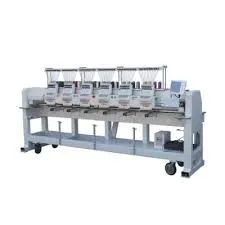8 月 . 14, 2024 09:04 Back to list
Comprehensive Guide to One Head Embroidery Machine Maintenance and Service for Optimal Performance
Essential Guide to Embroidery Machine 1 Head Service
Embroidery has long been cherished as both an art form and a method of personalizing apparel and textiles. For those engaged in this craft, particularly businesses, the efficiency and performance of the equipment are paramount. One of the most common and versatile machines in the embroidery landscape is the single-head (1 head) embroidery machine. Understanding how to service and maintain this essential piece of equipment is crucial for ensuring longevity, efficiency, and quality of work.
Understanding the 1 Head Embroidery Machine
A single-head embroidery machine is ideal for small businesses and individual users who wish to produce custom embroidery on various fabrics. These machines are designed for tasks such as personalizing clothing or creating small runs of embroidered products. Their ability to create intricate designs with high precision is what makes them a popular choice among embroiderers.
Importance of Regular Service
Regular servicing of an embroidery machine is vital for optimal performance. Like any complex machinery, parts can wear out or become misaligned over time. The primary goal of servicing is to ensure that the machine operates smoothly, which enhances productivity and reduces the likelihood of errors in embroidery projects.
Key Components to Service
1. Needles and Thread The needle is perhaps the most critical component of an embroidery machine. It should be checked frequently for wear and replaced regularly to prevent fabric damage and ensure clean stitching. Additionally, using the correct type of thread for the fabric and design is essential.
embroidery machine 1 head service

2. Bobbin and Tension The bobbin area should be cleaned regularly to avoid lint buildup, which can cause thread breaks and improper tension. The tension settings may need adjustment based on the type of thread and fabric being used. A proper balance between the upper and lower thread tension is vital for achieving high-quality embroidery.
3. Software Updates Many modern embroidery machines come with firmware that can be updated. Keeping the software current ensures compatibility with the latest design files and enhances functional capabilities.
4. Cleaning and Lubrication Regular cleaning of the machine from dust and fabric debris is necessary. Furthermore, lubrication of moving parts is crucial to keep the machine running smoothly and to extend its lifespan.
5. Calibration and Alignment Over time, the machine may become misaligned, affecting the quality of the embroidery. Regularly checking and recalibrating the machine can correct any misalignments, preventing costly errors in production.
Professional Service vs. DIY
While basic maintenance can often be carried out by the machine operator, certain aspects of servicing may require professional attention. If you notice persistent issues that basic troubleshooting cannot resolve, seeking a professional technician's help is advisable. Many manufacturers offer specialized servicing options for their machines, ensuring repairs are carried out using genuine parts.
Conclusion
In conclusion, maintaining a 1 head embroidery machine is essential for anyone serious about the craft of embroidery. Regular service not only prolongs the life of the machine but also ensures high-quality results in every project. By staying proactive about maintenance—cleaning and lubricating parts, replacing needles and tensioning threads, and seeking professional help when needed—users can enjoy uninterrupted service and produce impeccable embroidery. Ultimately, investing time and effort into machine maintenance translates directly to the quality of work and the success of an embroidery business.
-
Professional Embroidery Machines High-Speed Industrial Solutions & Custom Designs
NewsMay.30,2025
-
Premium 2-Head Embroidery Machines Reliable Manufacturers & Suppliers
NewsMay.30,2025
-
12 Head Embroidery Machines High-Speed & Precision Stitching
NewsMay.30,2025
-
Premium Tshirt Embroidery Machines High-Speed & Precision Stitching
NewsMay.29,2025
-
6 Head Embroidery Machines High-Speed Multi-Head Designs & Suppliers
NewsMay.29,2025
-
Commercial Automatic 2 Heads Embroidery Machine Caps and shirts 12 15 Needles Two Heads Computerized Embroidery Machine
NewsMar.07,2025

Copyright © 2025 Xingtai Pufa Trading Co., Ltd All Rights Reserved. Sitemap | Privacy Policy
